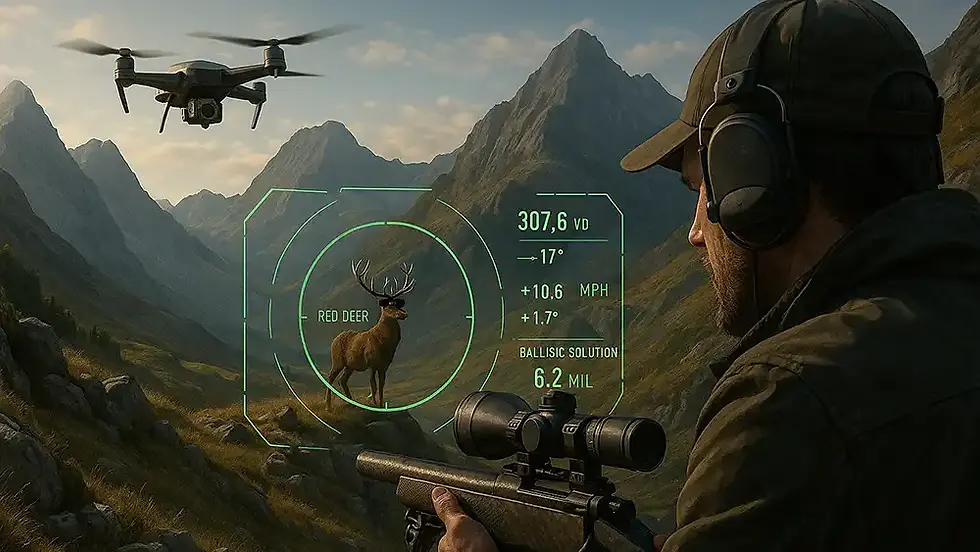The Wind – The Invisible Force That Shapes Every Hunt
- Hans ARC
- Nov 8
- 3 min read

The wind is the oldest hunting companion known to man—unseen, unpredictable, ever-present.
It carries scent, betrays presence, and changes perception. No modern optic, no thermal scope, no rangefinder can replace what it teaches us: patience, awareness, and the instinct for the invisible.
To stand in the woods and read the wind is to be in conversation with nature—and with yourself.
The Wind as Enemy and Ally
Every hunter knows the moment when everything aligns—the light, the stand, the animal easing through the brush. Then comes a subtle shift, a faint breath of air—and it’s over.
The wind turns, and the forest changes its mind.
The wind isn’t luck. It’s the silent director deciding whether the evening ends in stillness or success.
Game, especially deer, live through scent. Their survival depends on detecting danger before it appears. The wind is their information network.
And the hunter who ignores it will always lose that game.
But the hunter who studies it—its direction, strength, eddies, and moods—hunts with nature, not against it.
“Respect the wind, and the forest will speak to you.”
The Psychology of the Wind
They say the wind tests a hunter’s character.
Because it forces you to slow down.
To hunt with the wind is to wait, to feel, to be patient. It’s a discipline of the senses.
Modern hunters are used to control—data replaces instinct, numbers replace feeling. But the wind resists control. It’s wild, shifting, contradictory. And that’s what makes it sacred.
The wind teaches humility. Fight it, and frustration grows. Accept it, and you begin to see hunting not as a plan, but as a process. The wind sharpens awareness and trains perception—it grounds you in the present moment.
“Only when you become still do you truly hear the wind.”
Field Tactics – Hunting with the Wind
No two winds are the same.
In the timber they twist, along slopes they rise and fall, across creeks they swirl.
By dusk, they change again with the cooling air.
Thermals and slope winds
In the morning, warm air rises; in the evening, it sinks. Understanding these shifts is vital.
A smart hunter knows when the wind drifts uphill or down and chooses his spot accordingly.
Sit wrong, and you’re busted before you ever see a flicker of hide.
Eddies and pockets
In valleys, eddies often trap scent and spin it in circles. Better stay high, where your scent drifts away instead of pooling around you.
Wind direction and the stalk
Rule number one: Always hunt into the wind.
Let the air carry the scent of the animal to you—not yours to them.
Even a faint backdraft can blow the hunt.
Good hunters test the air constantly—with ash, smoke, or a small bottle of wind checker powder.

Scent, Instinct, and Trust
Psychologically, the wind mirrors our own awareness.
It reveals how willing we are to trust instinct over intellect.
Veteran hunters often say they can feel when the wind is right—long before they check it.
That sixth sense isn’t mystical; it’s experience. The brain quietly reads air pressure, humidity, and ambient sounds—and turns them into intuition.
When we trust that intuition, we move in sync with nature. Doubt it, and we lose rhythm—and with it, not just the hunt, but inner calm.
“Good hunting starts when you stop thinking and start feeling.”
When the Invisible Becomes Real
Some moments in the field cut deeper than any kill.
When the wind shifts, the deer vanish, and silence falls—you stand alone, surrounded by the scent of earth, pine, and cold air.
It’s a moment of humility.
You realize you’re part of something larger—and that success comes only when you learn to listen.
In that quiet, as the wind threads through the trees, you discover the true art of hunting: not the shot, but the stillness.
The Wind as Teacher
The wind is no enemy. It’s a teacher, a test, a companion.
It demands awareness, patience, and respect.
It reminds us that hunting is not just a physical act, but a state of mind—a balance of instinct, intuition, and restraint.
Try to master the wind, and you’ll lose.
Understand it, and you’ll hunt differently—quieter, humbler, more honest.
And maybe that’s the very essence that binds Shot & Silence:
Because in life, as in hunting, the wind will always change.
The art is learning how to stand your ground without losing your balance.




Comments